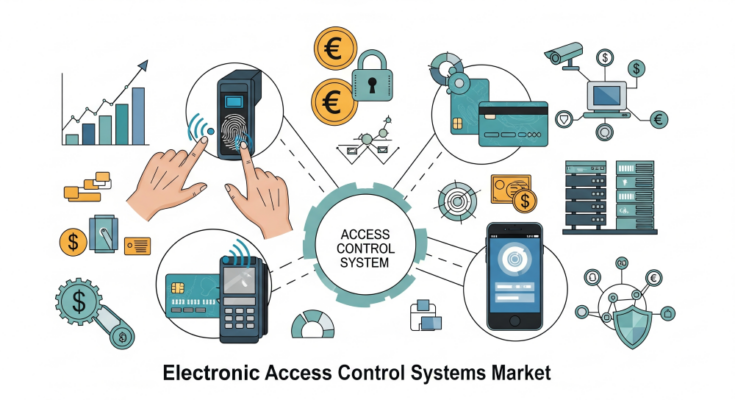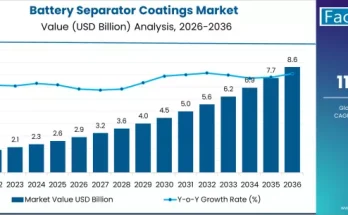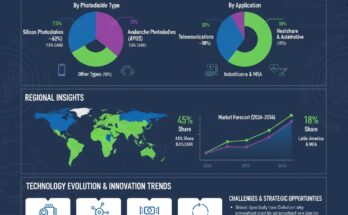As organizations increasingly prioritize security and operational efficiency, electronic access control systems are becoming a cornerstone of modern infrastructure. These systems manage and monitor entry to buildings, rooms, or digital resources, replacing traditional locks with sophisticated electronic solutions. The electronic access control systems market is witnessing significant expansion, driven by rising security concerns, technological advancements, and the growing adoption of smart building solutions.
Electronic access control is not just about restricting access; it integrates with security management, enabling organizations to monitor, record, and analyze entry and exit patterns. From corporate offices to healthcare facilities, these systems are crucial for safeguarding sensitive information, protecting assets, and enhancing workplace safety.
Market Overview
Electronic access control systems encompass a wide range of technologies, including card-based readers, biometric authentication, mobile credentialing, and cloud-based management platforms. These systems offer several advantages over traditional locks, including scalability, real-time monitoring, and the ability to integrate with broader security infrastructure.
Key components of an electronic access control system typically include hardware devices such as readers, controllers, and locks, as well as software for user management, reporting, and security analytics. The integration of artificial intelligence and IoT (Internet of Things) is further enhancing these systems, enabling predictive security measures and automated responses to unauthorized access attempts.
The demand for electronic access control solutions is driven by several factors:
- Rising security threats across commercial, residential, and industrial sectors.
- Growing adoption of smart buildings and connected infrastructure.
- Need for regulatory compliance in sensitive sectors like healthcare and finance.
- Technological innovations, including cloud-based solutions and mobile access credentials.
Regional Insights
North America
North America is a key player in the electronic access control systems market due to widespread adoption of advanced security solutions. Organizations in this region are increasingly investing in integrated security platforms, combining electronic access control with video surveillance, intrusion detection, and alarm systems. The emphasis on workplace safety, regulatory compliance, and smart office solutions further drives market growth.
Europe
Europe follows closely, with strict regulatory frameworks governing data privacy and building security. Industries such as healthcare, banking, and government institutions are investing heavily in electronic access control to mitigate security risks and ensure compliance with data protection laws. Additionally, the rise of green and smart building initiatives is contributing to increased adoption of integrated access management systems.
Asia-Pacific
Asia-Pacific is emerging as a significant market due to rapid urbanization, industrialization, and smart city development. Countries in this region are embracing advanced security solutions for commercial buildings, residential complexes, and industrial facilities. The growing awareness of cybersecurity and physical security integration is also fueling demand for electronic access control systems.
Other Regions
Other regions, including Latin America and the Middle East & Africa, are gradually adopting electronic access control solutions, supported by infrastructure development and rising security awareness. Market expansion in these regions is often driven by the increasing presence of multinational corporations and global standards for safety and security.
Key Trends & Forecast
Integration with IoT and AI
One of the most significant trends in electronic access control is the integration of IoT and AI technologies. Smart sensors, AI-based monitoring, and cloud-connected platforms enable real-time alerts, predictive analysis, and automated responses to security threats. This not only improves safety but also provides organizations with actionable insights to optimize operations.
Mobile and Biometric Access
Mobile access solutions, including smartphone-based credentials and contactless systems, are gaining popularity due to convenience and enhanced security. Biometric authentication, including fingerprint, facial, and iris recognition, is increasingly used in sensitive environments, offering a higher level of security compared to traditional keycards or passwords.
Cloud-Based Management
Cloud-based access control platforms are transforming the market by enabling remote monitoring, centralized management, and seamless integration with other security systems. Organizations can manage multiple sites, track access patterns, and implement policies from a single dashboard, reducing operational complexity and costs.
Cybersecurity Integration
As electronic access control systems become more connected, the need for robust cybersecurity measures is growing. Vendors are focusing on encryption, secure communication protocols, and multi-factor authentication to protect against cyber threats, ensuring the integrity of both physical and digital access control.
Collaboration with Public and Private Sectors
Collaboration between governments, industry organizations, and private security providers is becoming more common to develop standards, guidelines, and regulations for electronic access control systems. These initiatives ensure compliance, interoperability, and the adoption of best practices across industries.
Applications & End-Use Outlook
Commercial Buildings
Electronic access control systems are widely deployed in commercial buildings to protect employees, visitors, and assets. Integrated solutions with video surveillance and alarm systems provide a comprehensive security framework. Smart offices and coworking spaces increasingly rely on mobile credentials and cloud-based management platforms.
Healthcare Facilities
Healthcare facilities adopt electronic access control to safeguard sensitive patient data, pharmaceutical inventories, and medical equipment. Biometric and role-based access solutions ensure that only authorized personnel can enter restricted areas, complying with strict regulatory requirements.
Education Institutions
Educational institutions, including schools, colleges, and universities, utilize electronic access control to manage campus security. Systems help monitor entry points, restrict unauthorized access, and ensure the safety of students, faculty, and staff.
Industrial and Manufacturing
In industrial and manufacturing settings, electronic access control systems regulate entry to production floors, warehouses, and sensitive areas. Integration with workforce management and IoT-based monitoring enhances operational efficiency and safety.
Residential Complexes
Smart residential complexes increasingly adopt electronic access solutions to offer residents convenience and security. Features such as mobile credentials, video intercoms, and remote monitoring provide peace of mind and streamline access management.
Challenges in the Market
Despite the growth potential, the electronic access control systems market faces several challenges:
- High initial investment in advanced systems can deter small and medium-sized enterprises.
- Cybersecurity risks associated with connected platforms require continuous monitoring and updates.
- Integration complexity with existing infrastructure can pose challenges for organizations seeking to modernize their security systems.
- Regulatory compliance varies across regions, requiring adaptable solutions to meet different legal requirements.
Future Outlook
The future of the electronic access control systems market is promising, driven by technological innovation and increasing security awareness. Organizations are expected to adopt integrated security solutions combining physical and digital access control. Advancements in AI, machine learning, and IoT will further enhance the functionality, scalability, and effectiveness of these systems.
Emerging trends, such as predictive security, mobile-based credentials, and cloud management platforms, will continue to shape market dynamics. Companies investing in research and development, strategic partnerships, and customized solutions are likely to maintain a competitive edge.
Sustainability and energy efficiency are also expected to influence future developments. Electronic access control systems integrated with smart building technologies can reduce energy consumption, optimize building operations, and support green initiatives.
Conclusion
Electronic access control systems are transforming the way organizations secure their premises and manage access. The adoption of advanced technologies, integration with smart infrastructure, and emphasis on regulatory compliance are driving market growth. As security threats evolve and organizational requirements become more complex, these systems will play a critical role in ensuring safety, operational efficiency, and trust.
For businesses, educational institutions, healthcare facilities, and residential complexes, investing in robust electronic access control systems is no longer optional—it is essential. Comprehensive market analysis, awareness of emerging trends, and strategic planning can help organizations implement effective access management solutions, safeguarding both assets and people in an increasingly connected world.



